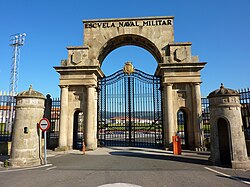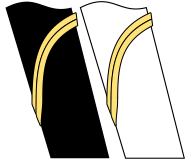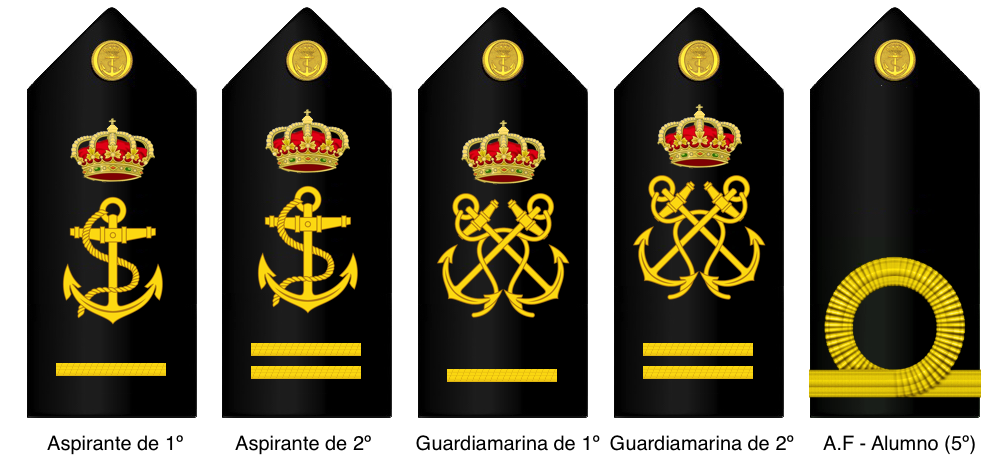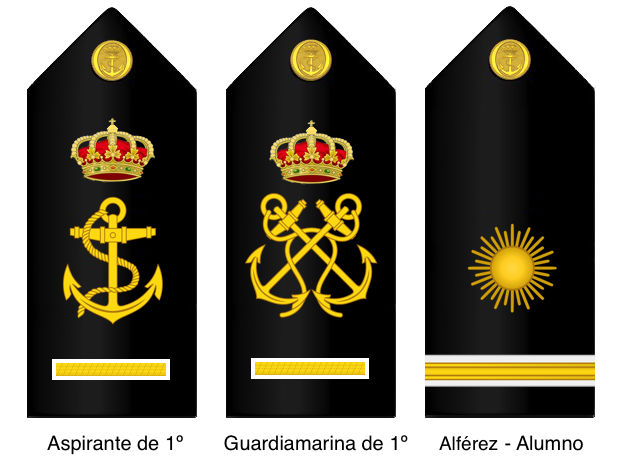Naval Military School (Spain)

The Escuela Naval Militar is a Spanish military academy. Founded in 1717 in the city of Cádiz, at the initiative of Minister José Patiño Rosales, since 1943 it has been located in Marín (Pontevedra). This center is responsible for the training of future officers of the Spanish Navy. The commanding officer of the Naval Academy is Captain Pedro Cardona Suanzes.
Both King Felipe VI and his father, King Juan Carlos I, completed part of their military training at this academy. It is expected that the Princess of Asturias, Leonor de Borbón, will develop her military training at this center in the 2024-2025 academic year.
The military career
The military career is developed at this School in five academic years for the officer scale. The students of the Corps, General of the Navy and Marine Infantry have the designation of applicants during the first two years, midshipmen during the 3rd and 4th courses, and student frigate lieutenants during the fifth or student lieutenants if They belong to the Marine Corps.
Students of the Quartermaster Corps are also trained at the Naval Academy, who enter after passing an opposition that can be accessed by having a university degree in Economics, Business or Law. They complete two academic courses: a first course, divided into two stages, the first as 1st year applicants and the second as 1st year midshipmen, and a second course as ensigns-students. After completing their studies, they graduate with the employment of Quartermaster Lieutenants.
Students from the Corps of Engineers spend a semester at the Naval Academy as 1st year candidates. After this period of military and seafaring training, they continued their studies at the Higher Technical School of Naval Weapons Engineers, in Madrid.
Aspiring volunteer reservist officers also carry out an adaptation period at the Naval Military School.
The training is academic and military, the practices are constant and a very strict and demanding schedule is followed.
Since the 2010-11 academic year, a new teaching model was implemented by which ENM students, in addition to military training, carry out university studies at the Defense University Center attached to the University of Vigo. In this center, students receive university training and, in line with the reform promoted by the Bologna plan, the Bachelor's degree in Mechanical Engineering upon completion of their studies. The University Defense Center has its own teaching staff who come, for the most part, from the University of Vigo.
His story

Academy of Marine Guards (Cádiz, 1717-1769)
In 1717, the first Company of Marine Guards was inaugurated in Cádiz, promoted by José Patiño. The aim was to provide mixed scientific-practical training to future Navy officers, seeking an intermediate between the British training of the midshipmen, eminently practical, and the training of the Gardes marins French, solidly theoretical. On February 7, 1717, it already had the first 37 future students. This Company of Marine Guards is the first antecedent of the current Naval Military School. Since its foundation, the Academy of Marine Guards held the main names of the educational centers: Academy and College when it was established in the Arsenal de la Carraca in 1824, and School, when in 1871 it was installed in Ferrol aboard the frigate Asturias.
The Corps of Marine Guards was considered a troop of the Royal House, and replaced the Standard Guards and the Cadets of Cartagena.
Marine Guards Academy (San Fernando -Cádiz-, 1769-1831)
On November 15, 1769, the Academy of Marine Guards moved to the Island of León.
Royal Companies of Marine Guards (1776-1824)
On August 13, 1776, the Royal Companies of Marine Guards were established in Ferrol and Cartagena, closing these centers in 1824. From 1825 to 1827 the Academy moved to the Carraca Arsenal.
After the academy closed in May 1831, the midshipmen went on to do their practices on the frigate Perla and on the ship Soberano.

Military Naval College (Town of San Carlos, in San Fernando -Cádiz-, 1845-1867)
From 1841 to 1844, Seville, Ferrol, San Fernando and La Carraca were considered the headquarters of the new Naval Academy, until it was decided to install the Military Naval College in the military town of San Carlos, in front of the arsenal of La Carraca, in San Fernando, the center being inaugurated on January 1, 1845. Classes began on March 8 with 80 students, of which 53 were candidates (new name for students in the lower grades) of the General Body.
Once they had passed the Aspirant courses, they embarked as second-class midshipmen on the corvette Isabel II where after four years and after an exam they were promoted to first-class midshipmen. Then they embarked until they had a vacancy as an officer, returning to the School for promotion to second lieutenant, provided that they had been embarked for at least six years on armed ships.
On January 11, 1859, the midshipmen began to carry out navigation practices on the ship Rey Francisco de Asís, the corvette Mazarredo and the brig Constitución. And a few years later on the corvette Villa de Bilbao.
In 1867 the closure of the Naval College was decided. In the 23 years of existence it had trained 1,002 students, distributed in 42 promotions. The difficulties of the Treasury and the revolution of September 1868 accelerated its closure. On September 10, 1869, the Floating Naval School was established on the pontoon frigate Asturias in Ferrol.
Naval Military School (Cádiz, 1913-1943)
Forty-five years later, on January 10, 1913 and in the same building where the Academy was, the new Naval Military School was inaugurated in the Apostadero of Cádiz, where it would remain until 1943. It was in that year when General Franco moved the School to Marín, its current location. Other geographical options to install the new headquarters of the School were at that time Cádiz, Ferrol, Cartagena, Mahón and San Sebastián.
Currently
Since the suppression of compulsory military service by the government of José María Aznar in 2001, the use of these facilities has been maintained and, in recent years, modernization actions have been carried out, such as the installation of a Center for Electromagnetic Measurements (Cemedem) or the adaptation of part of the old hospital into a Non-Commissioned Officers Residence.
Badges of Students of the Naval Military School
General Body
Marine Corps
Navy Quartermaster Corps
Army Corps of Engineers
Student caps
Brigadiers
Midshipmen of the 2nd year (4th year) who have demonstrated impeccable conduct, and are also very good students, can be appointed brigadier. The function of the brigadiers is to instruct and command the rest of the students (except for the 5th year student officers). The brigadier general and brigadiers are general corps midshipmen. Subbrigadiers are general corps midshipmen and marine infantry.
Brigadier classes:
- Brigadier general or brigadier of three stakes: he is the oldest guard in his promotion. The gallon consists of two "greas" stakes and in the middle a "fine".
- Brigadier or brigadier of two shelves: he is responsible for each of the brigades of students, there are usually five guards of this class (one for each brigade of students: 1.o, 2.o, 3.o, 4.o and another for the one known as 12th brigade (intendents, engineers and military complement)). The gallon is made up of two "greas" stakes.
- Subrigadier or brigadier of a stake: they help the two-stitch brigadiers to send the students' brigades, there are usually three subrigadieres for each brigadier. The gallon is formed by a "greasy" stake.
The stripes are worn on the right arm between the elbow and wrist, they are very similar to those worn by sergeants and first corporals, but placed inverted.
 |  |  | |||||||
| Brigadier General | Brigadier | Subrigadier | |||||||
Contenido relacionado
Carlos Medina Plascencia
Oswald Avery
Bjork Live Book




